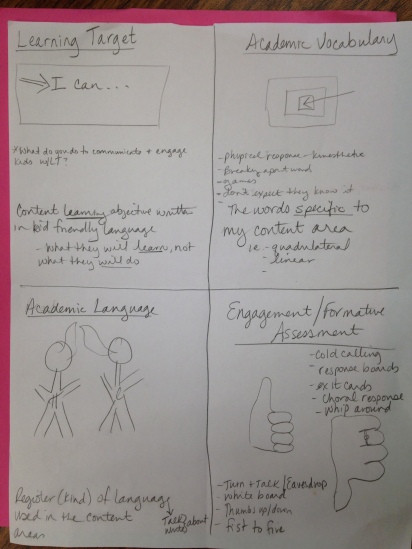
Are your students lacking motivation to begin a task? Does their typical discussion involve headphones and iPhones? Do they stop working at the first sign of trouble?
If so, read on…
As is often the case, I Googled one thing and found myself several links later reading Peter Liljedahl’s research on thinking classrooms and was fascinated. His research included 300 teachers, the majority of whom taught 6th-12th grade, on the elements that supported or impeded a thinking classroom.
“A thinking classroom is a classroom that is not only conducive to thinking but also occasions thinking, a space that is inhabited by thinking individuals as well as individuals thinking collectively, learning together and constructing knowledge and understanding through activity and discussion. It is a space wherein the teacher not only fosters thinking but also expects it, both implicitly and explicitly.” ~Peter Liljedahl, Associate Professor at Simon Fraser University, Canada
One of the elements Liljedahl found impactful was the student workspace.

And this is where it gets interesting.
Liljedahl looked at five different workspaces. He gave each group of 2-4 students only one pen to ensure group work, then gave students a task to solve. The five workspaces included:
- a wall-mounted whiteboard (vertical, non-permanent (i.e. easy to erase))
- a whiteboard laying on top of their desks or table (horizontal, non-permanent)
- a sheet of flip chart paper taped to the wall (vertical, permanent (i.e. can’t erase marks))
- a sheet of flip chart paper laying on top of their desk or table (horizontal, permanent)
- their own notebooks at their desks or table (horizontal, permanent).
Eight data points were collected to measure the effectiveness of each of the surfaces.
- Time to task
- Time to first mathematical notation
- Eagerness to start (A score of 0, 1, 2 or 3 was assigned with 0 assigned for no enthusiasm to begin and a 3 assigned if every member of the group were wanting to start.)
- Discussion (A score of 0, 1, 2 or 3 was assigned with 0 assigned for no discussion and a 3 assigned for discussion involving all members of the group.)
- Participation (A score of 0, 1, 2 or 3 was assigned with 0 assigned if no members of the group were active in working on the task and a 3 assigned if all members of the group were participating in the work.)
- Persistence (A score of 0, 1, 2 or 3 was assigned with 0 assigned if the group gave up immediately when a challenge was encountered and a 3 assigned if the group persisted through multiple challenges.)
- Non-linearity of work (A score of 0, 1, 2 or 3 was assigned with 0 assigned if the work was orderly and linear and a 3 assigned if the work was scattered.)
- Knowledge mobility (A score of 0, 1, 2 or 3 was assigned with 0 assigned if there was no interaction with another group and a 3 assigned if there were lots of interaction with another group or with many other groups.)
Here is the data:

Non-permanent surfaces outperformed permanent surfaces in almost every measure. Are students more willing to take risks when they are working on non-permanent surfaces?
Vertical surfaces outperformed horizontal surfaces in almost every measure. The act of standing reduces the ability to hide.
Vertical whiteboards decrease the amount of time it takes students to get something on their surface; from almost 2 1/2 minutes down to 20 seconds! Eagerness increases when moving to a vertical whiteboard – a perfect 3! And, Participation and Discussion jumped from less than 1 with a notebook to close to 3 with a vertical whiteboard.
How cool is that?! This is impactful data!
Get some white boards, people! Get them on the wall! Get them now!!
And, let me know how I can help!

P.S. If you are in need of super cheap whiteboards, just laminate a piece of construction paper or tag board!
P.S.S. Find a concise summary of Liljedahl’s research of the 9 elements of a thinking classroom here.
















